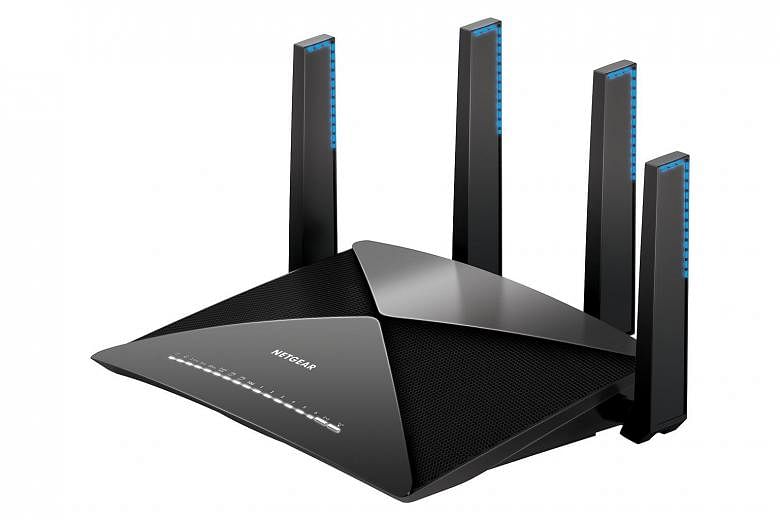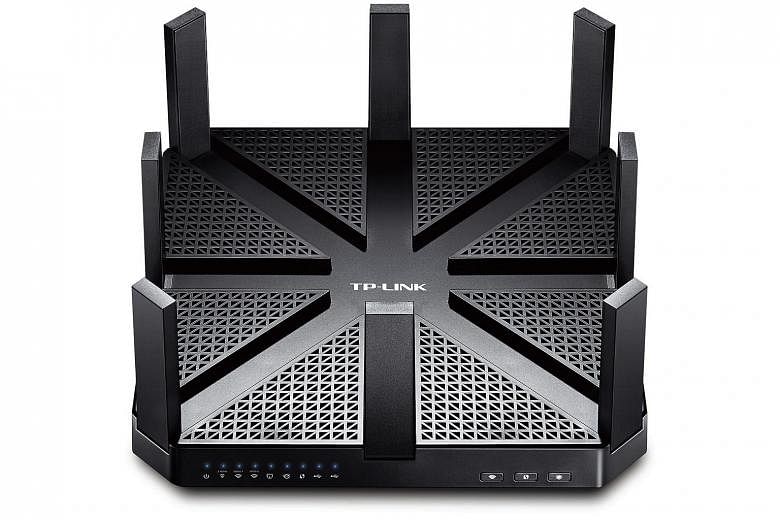A new wireless technology released last year promises to bring wireless speeds to match wired Ethernet. The new 802.11ad Wi-Fi standard operates at the 60GHz frequency, compared with the 2.4GHz and the 5GHz frequencies used by typical wireless standards.
Also known as WiGig, 802.11ad offers transfer speeds of up to 7Gbps, though today's 802.11ad routers are capped at 4,600Mbps.
But while lightning fast, 802.11ad has a very limited effective range of up to 10m. Its radio waves are also unable to pass through walls and other obstacles.
As a result, 802.11ad does not replace existing Wi-Fi standards, but complements them. You are more likely to find 802.11ad in devices such as wireless docks that require speed and are usually placed next to your computers. I know of just one Acer laptop that supports 802.11ad at the moment, though you can probably expect a handful of new 802.11ad client devices this year.
THere are two 802.11ad routers in the market now.
NETGEAR NIGHTHAWK X10 SMART WI-FI ROUTER
The Netgear Nighthawk X10 Smart WiFi Router is evidence that the arms race among networking vendors has reached farcical levels.
Because inside a hefty 1.9kg chassis that, to my surprise, can be wall mounted, the X10 packs everything but the kitchen sink.
In fact, I am not even sure that the X10 should be called a router. Perhaps Netgear should dub it an All-in-One Networking Computer.
Firstly, it supports the 802.11ad wireless technology.
It is also the first home router to run Plex, a popular media server software. Using Plex, you can stream music and videos from a storage drive attached to the X10's USB 3.0 port to other devices on the home network.
-
TECH SPECS - NETGEAR
PRICE: $799
ETHERNET INTERFACE: 1 x 10/100/1,000 Gigabit WAN, 6 x 10/100/1,000 Gigabit LAN
STANDARDS: 802.11a/b/g/n/ac/ad
SECURITY: WPA/WPA2, WEP
ADVANCED FIREWALL FEATURES: NAT, SPI and DoS protection
RATING
FEATURES: 5/5
DESIGN: 4/5
PERFORMANCE: 4/5
VALUE FOR MONEY: 1/5
OVERALL: 4/5
TECH SPECS - TP-LINK
PRICE: $499
ETHERNET INTERFACE: 1 x 10/100/1,000 Gigabit WAN, 4 x 10/100/1,000 Gigabit LAN
STANDARDS: 802.11a/b/g/n/ac/ad
SECURITY: WPA/WPA2, WEP
ADVANCED FIREWALL FEATURES: NAT, SPI and DoS protection
RATING
FEATURES: 4/5
DESIGN: 4/5
PERFORMANCE: 3/5
VALUE FOR MONEY: 2/5
OVERALL: 3/5
Plex is usually installed in PCs or network-attached storage (NAS) devices. But apparently, the X10's 1.7GHz dual-core chip is capable enough to run Plex, on top of its other router duties.
Netgear bundles a three-month Plex Pass that unlocks premium features like high-quality metadata for music and parental controls.
In addition, the X10 can connect to Amazon Drive storage, to back up your files automatically to the cloud. But Netgear provides only six months of free unlimited Amazon Drive backup.
Other high-end features include a 10 Gigabit SFP+ port that connects to a compatible NAS for high-speed file backups; and port aggregation, which combines the throughput from two reserved Gigabit Ethernet ports to achieve higher transfer speeds of up to 2Gbps.
There is even a BitTorrent download manager, still in beta testing, that lets you download files from the Internet to an attached USB storage drive.
It all sounds good, but the thing is that the average consumer would probably not even use half the high-end features on this router.
Netgear has introduced a new and simple mobile app called Up (for iOS and Android) that lets you set up the router using a mobile device instead of a PC.
However, I was disappointed to find out that you'll still have to use the Netgear Genie app, which looks extremely dated, to control the router's settings.
I found myself using the PC browser interface instead, which offers more options and is more user friendly. The time taken to load the settings, however, could be shorter.
Since I did not have a compatible 802.11ad device, I could only test the X10 like any other 802.11ac router. The X10 managed around 552Mbps in our speed test, compared with 695Mbps recorded on my current speed champ, the Asus RT-5300.
At $799, the Netgear X10 is by far the most expensive router in the market. The high price is somewhat understandable, given its rich feature set. But most users would see little benefit from getting the X10 over a cheaper 802.11ac router.
TP-LINK TALON AD7200 MULTI-BAND WI-FI ROUTER
TP-Link was the first to launch an 802.11ad router last June, with its Talon AD7200. It is a tri-band model that supports up to 800Mbps on the 2.4GHz band, 1,733Mbps on the 5GHz band, and 4,600Mbps on the 60GHz band used by the 802.11ad Wi-Fi standard.
As with the Netgear X10, I reviewed the Talon only for its 802.11ac Wi-Fi technology, since I did not have a compatible 802.11ad device.
The Talon has an eight-antenna design similar to TP-Link's tri-band AC5400 router. Its front LED status indicators, as well as the wireless feature, can be turned off by pressing the front-panel buttons.
The router is relatively light and can be mounted vertically on a wall, though TP-Link recommends that you keep it horizontal for best performance.
When I first logged in to the router settings using a browser, it asked me to change the password. This is good because keeping the default passwords makes it easy for hackers to gain access.
The router even tells you if your new password is weak and can be easily deduced.
The Talon's user interface is clean and bright. It feels welcoming, compared with the cluttered and complicated ones on other routers. A small Help icon at the top right corner opens a glossary of common networking terms, though the explanations are a bit too simplified.
Features that you'd expect on a router in its class - parental controls, guest network and quality-of-service (QoS) - are all here, and they are easy to configure.
TP-Link's companion Tether app (for iOS and Android) offers far fewer options than the browser-based interface, so it cannot entirely replace the PC as a way of controlling the router.
But Tether is well-designed with a sleek user interface. It guides the user step by step and I never had to click more than a few times to complete my task.
The Talon managed around 352Mbps in our 802.11ac speed test, which puts it in the middle of the pack compared to top performers that achieve over 500Mbps.
•Verdict: The Netgear Nighthawk X10 Smart WiFi Router, a super high-end router, feels like a tech demo, rather than a device for consumers.
As for the TP-Link Talon AD7200 Multi-Band Wi-Fi Router , unless you really need its 802.11ad wireless feature, there are cheaper and better-performing routers. But credit to TP-Link for producing a clean user interface and a slick companion mobile app.



